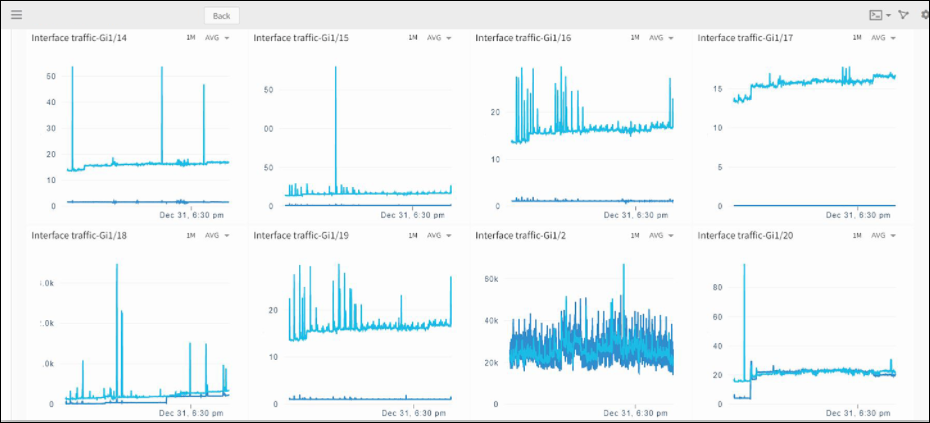Introduction
SNMP monitoring includes:
- Creating SNMP monitors using one of the following:
- Collector Type: SNMP
- Collector Type: SNMP Extended (Script-based)
- Creating a template with an SNMP monitor.
- Assigning the template to a resource.
- Viewing graphs.
Before you begin
Before getting started with monitoring, do the following:
- Setting up instrumentation strategy.
- Creating gateway management profiles.
- Setting up discovery profiles.
Setting up instrumentation strategy
Creating gateway management profiles
The gateway management profile helps in managing the discovery of resources. For more information, see Create Gateway Management Profiles.
Setting up discovery profiles
An administrator can create discovery profiles based on the devices to discover. Discovery and Deployment page displays the added discovery profile. For more information, see Discovery Profile.
Creating SNMP monitors with collector type SNMP
Creating SNMP monitors helps the administrator to initiate the monitoring and set thresholds to receive alerts.
To create an SNMP monitor:
- Select a client from the All Clients list.
- Select Setup > Monitoring > Monitors.
- From the MONITORS screen, click + Add.
- From CREATE A MONITOR, provide the following details:
- Monitor Scope: Select Partner or Client-Specific Monitor.
Select a client for Client-Specific Monitor. - Adaptor Type: Refers to the monitor type. Select SNMP.
- Name: Refers to the unique name for the monitor.
- Description: Refers to the details of the monitor.
- Is this monitor for a component that has multiple instances?: Select one of the following options:
- Yes: Select for Tabular OID.
If you select Yes, the CREATE A MONITOR screen displays Component Properties, Additional Properties, Metrics, and Data Collection Rules sections. - NO: Select for Scalar OID.
If you select No, the CREATE A MONITOR screen displays only the Metrics section.
- Yes: Select for Tabular OID.
- Monitor Scope: Select Partner or Client-Specific Monitor.
- From the Component Properties section, provide the following details:
- Mode: Refers to the method to get the value or name of the component. Select one of the following options:
- Get Value: Refers to the unique name of the component.
- Get Index: Refers to the index value of the OID.
- Lookup Index: Refers to the index of the OID and matches with the index of the Lookup OID. For more information, see Lookup Index.
- Lookup Value: Refers to the value of the OID and matches the index of the Lookup OID. For more information, see Lookup Value.
- OID: Refers to the OID of the component.
- Lookup OID: Refers to the OID of the object from another table with the same MIB as the component OID.
The field is active only if you select Lookup Index or Lookup Value. - Format: Refers to the data type of the OID in the MIB.

Component Properties
- Mode: Refers to the method to get the value or name of the component. Select one of the following options:
- From the Additional Properties section, do the following:
- Click +Add.
- From the Additional Properties window, provide the following:
- Name: Refers to the name of the OID.
- OID Type: Select one of the following options:
- Scalar OID
- Tabular OID
- OID: Refers to the OID of the component to add the property.
- Format Value: From the options displayed in the drop-down menu, select Enumerated Map.
- Provide an enumerated map: Provide the key and value pair for each OID.
- Unit: From the options displayed in the drop-down menu, select the desired unit.
Note: Skip Unit selection if an enumerated map is already selected.
- Click Add.

Additional Properties
- From the Metrics section, do the following steps:
Click +Add.
From the Add Metric window, go to the Add metric section and provide details for the following:
- Name: Refers to the name or label to define the metric displayed on the graphs. For example, hr.storage.utilization.
Important!- No Uppercase or space allowed.
- Follow dotted notation.
- Display Name: Refers to the name or label to define the metric displayed on the dashboard.
- Description: Refers to the reason for using the metric.

Add Metric
- Name: Refers to the name or label to define the metric displayed on the graphs. For example, hr.storage.utilization.
From Value of the metric, do the following:
- Go to Provide SNMP OID-based inputs.
- Click +Add and provide the following:
- Name: Refers to the object name of the OID defined in the MIB.
- OID: Refers to the OID defined in the MIB.
Important! The scalar OIDs must end with.0. - OID Type: Refers to the scalar or tabular OID.
- Data Type: Refers to the base syntax of the OID defined in the MIB. Select the data type according to the metric under creation.
- Formula: Select one of the following options:
- Delta: Provides the difference between the current poll value and the previous poll value.
- Rate: Provides the quotient of the difference between Current Poll Value and Previous Poll Value with Current Poll Time and Previous Poll Time.
Arithmetically, Rate = (Current Poll Value)-(Previous Poll Value)/(Current Poll Time)-(Previous Poll Time).
Rate returns the value in per second format. For example, Requests per second, bytes per second, errors per sec, and per sec.
- Poll Frequency: Refers to the frequency for monitoring the devices. Select one of the following:
- User-Defined: Select if the chosen OID requires frequent monitoring.
- Less Frequent: Select if the chosen OID is monitored seldom. The OIDs are polled every eight hours.
- Go to Does the metric need more inputs from the user?.
- Click + Add and provide the following:
- Name: Refers to the name of the variable used while calculating the value of the metric.
- Description: Refers to the information about the variable.
- Default Values: Provide a value for the variable. For example, if you want to monitor the network interface bandwidth for WAN links, provide ISP speed value in Mbps, Kbps, or bps.
- Go to Calculate the value of the metric.
- From Metric Value, select one of the following options:
- Value of the SNMP OID: Selected by default when only single SNMP OID-based input entry is available.
- Using the inputs provided above, derive the value of the metric using an expression: Provide the Java-based mathematical expression to calculate the OID output.
Example: (used/(used+free))*100, whereusedandfreeare SNMP OID-based names. For more information, see Java-based Mathematical Expression Examples.
Note: Use this option to:
- Get a single OID value as a metric result for multiple OID inputs.
- Perform more mathematical calculations for multiple OID results.
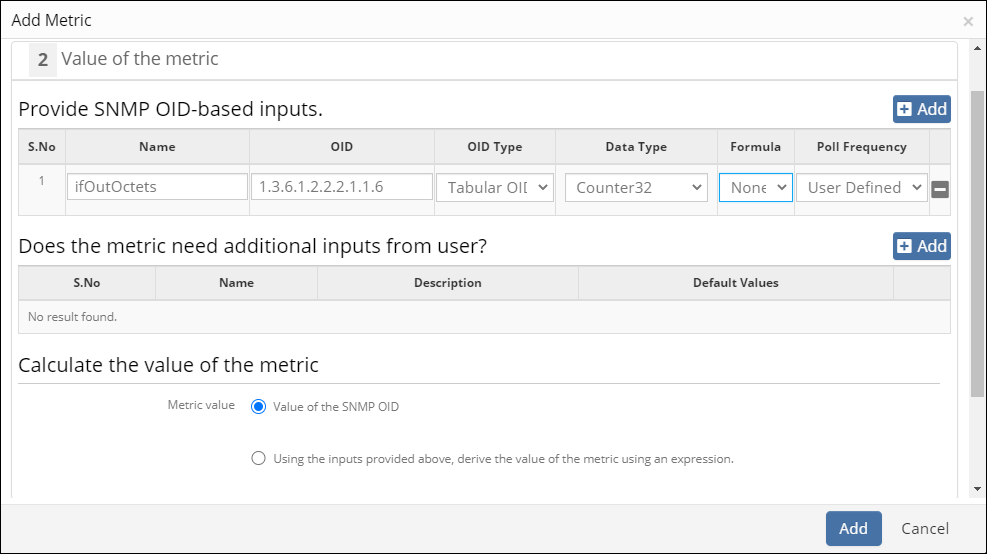
Value of the Metric
From Format metric value, do the following:
- From the options displayed in Format metric value using drop-down menu, select Enumerated Map.
- From Provide an enumerated map, enter the key and value pair for each OID. For example, the enumeration values for device health status OIDs are:
- 1 - up
- 2 - down
- 3 - testing
- 4 - downgrade
- 5 - warning
- From Use formatted value in, select the checkbox for one of the following:
- Alerts: To receive alerts.
- Graph: To generate metric graphs.
- From the options displayed in the Units drop-down menu, select the desired unit according to the metric value. For example, for performance OIDs, select Percentage(%).
Note: Skip Units selection if an enumerated map is already selected. - From Graph, select
Yesto populate graphs for a metric.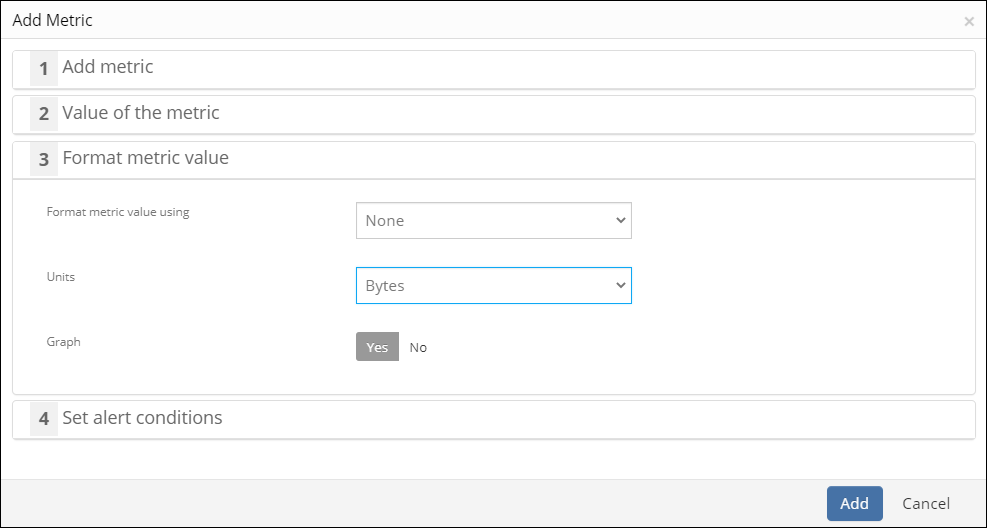
Format Metric Value
From Set alert conditions, provide details for the following:
- Warning severity: Refers to the warning alert generated when the metric matches the operator and breaches the warning threshold value.
- Critical severity: Refers to the critical alert generated when the metric matches the operator and breaches the critical threshold value.
- Alert Subject: Refers to the alert subject displayed for a warning or critical alert on the alert browser. For more information, see Alert Subject Tokens.
Note: The actual values replace the alert subject displayed on the alert browser. - Alert Content: Refers to the alert description displayed on the alert details page. For more information, see Alert Content Tokens.
Note: The actual values replace the alert subject displayed on the alert browser.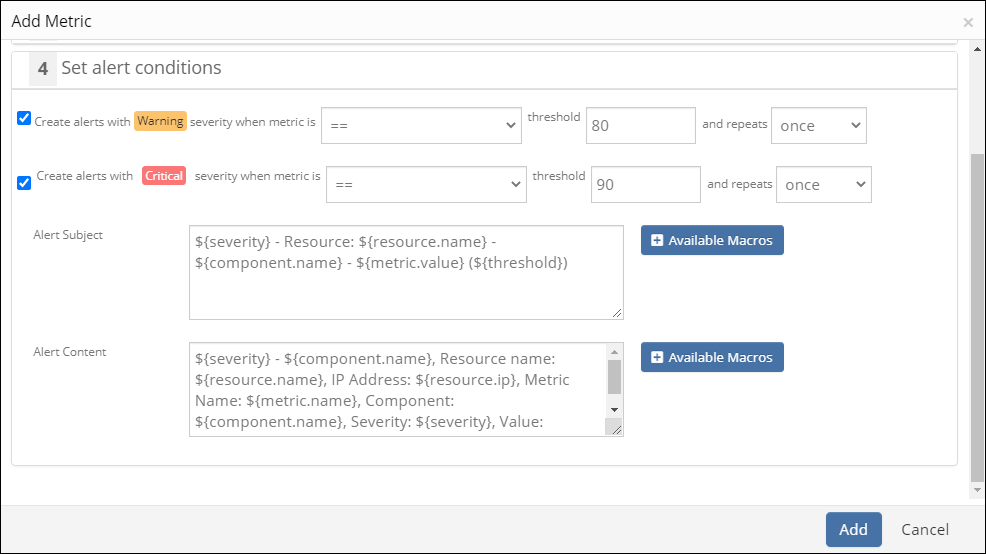
Set Alert Conditions
- From the Data Collection Rules section, select one of the following options to select the instances to monitor:
- All instances of this component: Monitors all component OIDs (Default selection).
- Automatically select instances based on the below-mentioned rules: Add Value for the selected Property and Operator defined in the Additional Properties section to filter the monitoring components.
- Manually select instances on the device based on the following properties: Select the desired components added in the Additional Properties section.
Note: You can view and choose the manually selected components while assigning templates to a resource.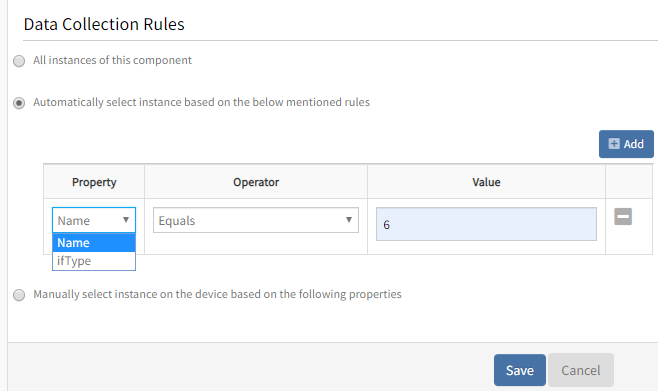
Data Collection Rules
- Click Save.
The MONITOR screen displays the SNMP monitor.
Creating SNMP monitors with collector type SNMP Extended
Use SNMP Extended (script-based), if you are unable to get the device or specific metric support using SNMP collector.
Prerequisite
Knowledge of Core Java or Groovy script.To create an SNMP Extended monitor:
- Select a client from the All Clients list.
- Select Setup > Monitoring > Monitors.
- From the MONITORS screen, click + Add.
- From CREATE A MONITOR, provide the following:
- Monitor Scope: Select Partner Monitor or Client-Specific Monitor.
Select a client for Client-Specific Monitor. - Adaptor Type: Refers to the monitor type. Select SNMP Extended.
- Name: Refers to the unique name for the monitor.
- Description Refers to the details of the monitor.
- Script: Provide the script in the text box. For reference, see Sample Script.
- Does it need user input(s): Select one of the following:
- Yes: Select to monitor specific attributes of the user input.
- No: Select to monitor all user inputs.
- If you select Yes, select one of the following scopes:
- Component Level: Select this option if you have the same input for all components.
- Monitor Level: Select this option if you have different inputs for each component.
- Monitor Scope: Select Partner Monitor or Client-Specific Monitor.
- From Configuration Parameters, click + Add and provide the following:
- Name: Refers to the name of the variable. Use this name to parse the variable into the script.
- Display Name: Refers to the name displayed for the variable.
- Description: Refers to the information about the variable.
- Default Values: Provide a value for the variable. For example, to monitor the network interface bandwidth utilization for WAN links, provide ISP speed value in Mbps, or Kbps or bps.

Configuration Parameters
- From Metrics, click +Add and do the following:
- From the Add Metric window, provide details for the following and click Add:
- Name: Refers to the name or label to define the metric displayed in the graphs. For example, hr.storage.utilization.
Notes:- No Uppercase or spaces allowed.
- Follow dotted notation.
- Display Name: Refers to the name or label to define the metric displayed on the dashboard.
- Description: Refers to the reason for using the metric.
- Units: From the options displayed in the Units drop-down menu, select the desired unit.
- Format metric value using: From the options displayed in the drop-down menu, select Enumerated Map.
- Provide an enumerated map: Provide the key and value pair for each OID.
- Graph: Select
Yesto populate graphs for a metric. Else select No.
- Name: Refers to the name or label to define the metric displayed in the graphs. For example, hr.storage.utilization.
- From Alerts, provide details for the following:
- Warning severity: Refers to the warning alert generated when the metric matches the operator and breaches the warning threshold value.
- Critical severity: Refers to the critical alert generated when the metric matches the operator and breaches the critical threshold.
- Alert Subject: Refers to the alert subject displayed for a warning or critical alert on the alert browser.
Note: The actual values replace the alert subject displayed on the alert browser. - Alert Content: Refers to the alert description displayed on the alert details page.
Note: The actual values replace the alert subject displayed on the alert browser.
- From the Add Metric window, provide details for the following and click Add:
- Click Save.
Creating SNMP template
To create a template:
- Select a client from the All Clients list.
- Select Setup > Monitoring > Templates.
- Click +Add.
- From MONITOR TEMPLATE, provide the following and click Save:
- Select Template Scope: Refers to the Partner template or Client-Specific template. For Client-Specific template, select the client.
- Collector Type: Refers to the application type that you want to gather the information. Select Gateway.
- Monitor Type: Select Monitors.
- Applicable for: Refers to the type of the application.
- Template Name: Refers to the name of the template.
- Description: Refers to the summary of the template.
- Generation: Refers to the template generation. For example, G2.
- Tags: Refers to the user-defined tags for better filtering.
- Prerequisites: Refers to the essential things that you must consider while using the template.
- Status: Refers to the Active or End-of-life templates.
- Notes: Refers to the information that you want to add to the template.
- Template Family Name: Refers to the category that applies to the application. For example, Windows Server, Storage Server, and Network Server.
- Deployment Type: Refers to one of the following methods to apply the template to the resources:
- Custom
- Optional
- Standard
After providing the template details, MONITOR TEMPLATE displays the Monitors section.
Note: The console for the Monitors section varies with the option selected in the Collector Type.
- Monitor: To add details in Monitors:
- From the Monitors section, click the +Add.
- From the Monitor window, provide the following:
- Frequency: Refer to the rate to execute the template.
- Monitor Definition: Refers to the monitor type.
- When to Alert: Select Breach of a Threshold.
- Select the Alert and Availability checkbox to initiate monitoring.
Assigning the template to a device
After creating a template, assign the template to the resource.
Important
Create Credentials to assign a template to a resource.To assign a template to a resource:
- Select a client from the All Clients list.
- Go to Infrastructure > Resources.
- From Resources, click the desired SNMP resource name > resource Details > Monitors > Template.
- From the Templates screen, click +Assign Templates.
- From Apply Templates > Select Templates > Available templates, select the desired templates.
- Click Assign.
The Templates screen displays the selected templates.
Viewing graphs
The gateway monitors the application using the assigned templates and displays the results in a graphical format. Click desired SNMP resource name > resource Details > Metrics to view the graphs.
